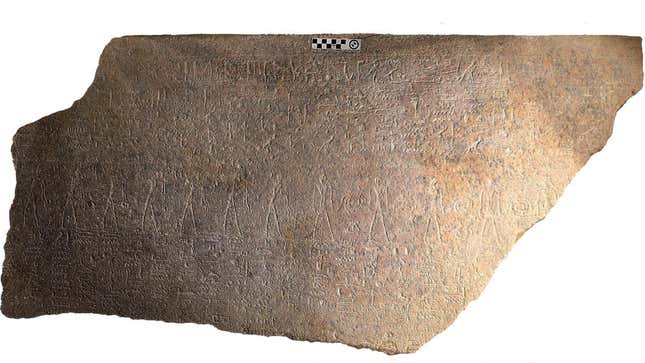
An engraved stone slab found under a Coptic building in Abydos, Egypt, is part of the sarcophagus of Ramesses II, according to a team of archaeologists who analyzed the hieroglyphics on its side.
Ramesses II was an ancient Egyptian pharaoh who reigned from 1279 BCE to 1212 BCE; he lived to be over 90 years old and may have fathered around 100 children, according to the Egypt Museum.
Advertisement
The granite sarcophagus fragment was found in 2009 but was for years could only be attributed to a high-ranking official of the New Kingdom. Now, archaeologists revisited the hieroglyphics—the Ancient Egyptian pictorial writing system—on the slab and found a cartouche that translates to “of Ramesses II himself,” indicating the stone piece was once part of the container for the ruler. The team’s research was published in the Revue d’Égyptologie.

Advertisement
According to a release published last week by France’s National Center for Scientific Research, the sarcophagus had carried two different individuals, but only one was known until now: Menkheperre, a high priest who lived around 1000 BCE, some 200 years after Ramesses II (Menkheperre is also the throne name of the pharaoh Thutmose III, whose mummy is on display in the Royal Mummies Hall of the National Museum of Egyptian Civilization). The identification of the recent cartouche on the sarcophagus suggests that its other occupant was once the famous pharaoh.
Ramesses’ mummy was moved repeatedly after burial to prevent looting and was eventually found at Deir el-Baharin in 1881 alongside other remains, including those of his father, the pharaoh Seti I. Ramesses’ mummy was found in a carved cedar coffin which was not originally designed t0 house the pharaoh, according to the Australian Museum.
Advertisement
Ramesses II’s mummy is well-preserved, despite its several moves. How the mummy initially became separated from its apparent sarcophagus is not clear, but what matters is that the mummy made it to the present day. Now we just need someone to find Alexander the Great. And Cleopatra. The list goes on, but Ramesses II and his sarcophagus are evidence that sometimes it just takes a little patience to reveal the past.
More: X-Ray Imaging Reveals Hidden ‘First Drafts’ in Ancient Egyptian Paintings
Services Marketplace – Listings, Bookings & Reviews